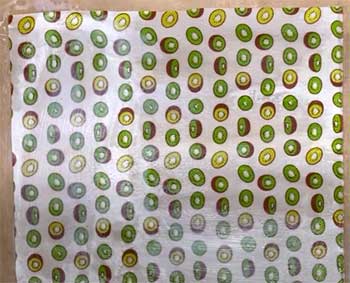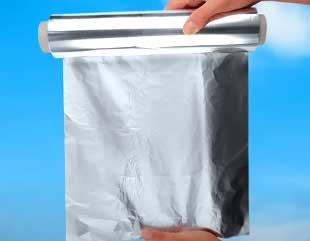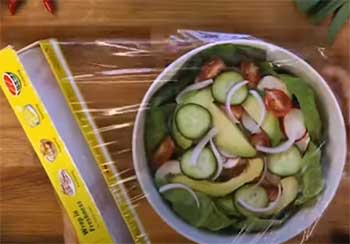Press’n Seal plastic wrap has become a staple in many kitchens. This cling wrap seals tightly to containers to keep food fresh. However, some consumers want an eco-friendly alternative that is reusable or recyclable.
Here is an in-depth look at the pros and cons of various Press’n Seal alternatives.
Alternatives To Press’n Seal Plastic Wrap
Here is a list of its substitutes:
- Beeswax Food Wraps
- Silicone Food Covers
- Parchment Paper
- Reusable Storage Containers
- Aluminum Foil
- Bread Bags and Resealable Bags
- Wide Canning Lids
- Plant-Based Cling Wrap Alternatives
Let’s elaborate its close competitors in detail:
Beeswax Food Wraps
Beeswax wraps provide a reusable and compostable alternative to plastic cling wrap. Here are the main pros and cons of using beeswax wraps instead of Press’n Seal:
Pros

- Reusable – Wipe clean between uses and reuse many times
- Biodegradable and compostable wrap
- Made from all-natural ingredients like cotton, beeswax, jojoba oil or pine resin
- Seal is airtight enough for most food storage needs
- Washable and antibacterial properties of beeswax prevent bacterial growth
- Can mold wrap around various container shapes
- Soften at room temperature to get tight seal
Cons
- Not as stretchy or flexible as plastic wrap
- Seals may weaken after many uses and washes
- Limited heat resistance as beeswax can melt
- Needs proper care like gently handwashing
- Slight residue from the wax may transfer
- More costly than disposable plastic wraps
Overall, beeswax food wraps are an excellent eco-friendly alternative as long as you don’t expose them to high heat. With proper care, they can be reused for up to a year before replacing. The wraps hold in moisture and freshness surprisingly well.
Silicone Food Covers
Silicone food covers provide a reusable alternative to Press’n Seal. Here is a comparison of their pros and cons:
Pros
- Reusable over and over
- Dishwasher safe
- Maintain shape well for tight seals
- Withstand oven and freeze temperatures
- Prevent splatters in microwave
- Often come with bands to seal covers to containers
- Liquid and stain resistant
- Available in various sizes and shapes
- Hygienic nonporous material prevents bacterial growth
Cons
- Not biodegradable or compostable
- May retain stains and odors over time
- Not as malleable for sealing irregular shapes
- Must store properly to prevent damage
- Can be bulky for storage
Silicone covers form a super tight seal to maintain freshness. Although they are reusable, ensure not to cut the silicone with utensils. Over time, extensive use and washing may lead to reduced efficiency and staining.
Parchment Paper
Parchment paper is another alternative to Press’n Seal plastic wrap for covering bowls and dishes. Here are its notable pros and cons:
Pros

- Disposable paper is more eco-friendly than plastic
- Fiber-free and chemical-free natural nonstick surface
- Oven and microwave safe up to 420°F
- Moisture and grease resistant
- Easy molding over container edges
- Prevents Refrigerator odors from seeping into dishes
Cons
- Limited uses as not strongly impermeable
- Can’t tightly seal containers for long-term storage
- Not reusable
- Direct food contact could soak up moisture
- Relatively flimsy
Parchment paper works nicely to keep leftovers fresh in the fridge for a few days. However, it should not replace plastic wrap for long term storage needs.
Reusable Storage Containers
Using reusable food containers is an alternative approach to plastic wrap. Here is an overview:
Pros
- Airtight BPA-free plastic or glassware containers
- Clear designs allow you to see contents
- Reusable repeatedly
- Lids have silicone seal ring for freshness
- Variety of sizes and shapes
- Microwave and dishwasher safe
- Can freeze foods without leaking
- Easy labeling with chalk markers
Cons
- Must store containers when not in use
- Not as adaptable as plastic wrap for all storage needs
- Could stain or retain odors if not washed properly
Investing in reusable containers can drastically reduce your need for any plastic wrap. Choose containers made from sustainable materials like glass or medical-grade plastics. Standardize your collection to a few set shapes and sizes for efficiency.
Aluminum Foil
Standard aluminum foil remains popular to wrap leftovers for the fridge or freezer:
Pros

- Impermeable to moisture and air
- Moldable to various containers
- Disposable foil is more eco-friendly than plastic
- Excellent freezer performance to retain freshness
- Can reuse foil a few times if careful
- Withstands oven heat for heating leftovers
Cons
- Foil tears more easily than Press’n Seal wrap
- Not transparent so you can’t view contents
- Could react with acidic foods over time
- Must discard after a several uses due to holes
- Foil recycling can be more challenging than plastic
Aluminum foil works reasonably well for food wrapping as an alternative to Press’n Seal. Just take care when handling sharp utensils around the thinner foil material during unwrapping. Also, limit microwave uses for foil as it can damage the appliance at high heat.
Bread Bags and Resealable Bags
Using simple bread bag clips or reusable resealable plastic bags provides another easy Press’n Seal substitute:
Pros
- Air tight seal to maintain food freshness
- See food contents through transparent plastic
- Mold bags over containers easily
- Reclose bags after opening with zip strips or clips
- Softer and more pliable than foil for tight wraps
- Variety of bag sizes including large rolls
Cons
- Still contributes to plastic waste in landfills
- Disposable versions aren’t truly reusable
- Can be challenging to remove all air from bag
- Cheaper bags may split more readily
- Not suitable for heating leftovers
- Limited temperature range depending on plastic
Overall, disposable slider bags offer a direct one-to-one swap for Press n’ Seal with the main drawbacks being single-use waste. Investing in reusable silicone zipper bags helps limit waste while retaining the sealing performance during storage.
Wide Canning Lids
For large bowl coverage, wide canning lids provide a sturdy seal. Here is an overview:
Pros
- Heavy-duty rimmed plastic lids fit wide items
- Seal tightly with rubber gasket rings
- Most brands made in USA
- Impermeable and moisture resistant surface
- Available in packs of mixed sizes
- Reuse lids many times
Cons
- Not flexible so harder to seal odd-shaped items
- Mainly just fit canning jars and wide bowls
- Need to store lids properly between uses
- Not suitable for microwave or heating leftovers
These rigid lids work effectively for covering leftover grain and salad bowls, as well as sealing canning jars. They make a great supplement to other eco-friendly wraps to cut back on plastic waste.
Plant-Based Cling Wrap Alternatives
An emerging category is plant-based cling wrap alternatives to single-use plastic wrap. Most versions combine plants like eucalyptus and cassava with non-toxic resins to mimic plastic cling wraps.
Pros

- Biodegradable and compostable materials
- Renewably sourced versus petroleum-based
- Transparent view of contents
- Seal containers similar to Glad cling wrap
- Fully impermeable to block air and moisture
- Resistance to oils and water
- Tear-resistance comparable to normal plastic wraps
- Can compost commercially if home compost not available
Cons
- Often pricier than traditional plastic wraps
- Limited sizes and availability still
- Needs proper composting facilities to break down
- Durability not yet as robust as standard cling films after extended use
- Fewer customer reviews due to novelty
These innovative options aim to prevent single-use plastics from ending in oceans and landfills. While promising, they remain newly launched to market so have limited purchase locations currently.
Frequently Asked Questions (FAQ)
Here are answers to some common questions about Press’n Seal wrap and its alternative products:
Press ‘n Seal is a major brand name by Glad for their plastic cling wrap products. So Press ‘n Seal wrap is a type of cling film. The main difference is that Press ‘n Seal uses adhesive chemicals so the plastic film can adhere tightly to bowls and containers by pressing it down. Typical cling films like Glad Cling Wrap rely only on static electricity to lightly cling or stick to surfaces.
Technically, you can attempt to reuse Press ‘n Seal plastic wrap if it still seems tightly sealed without holes after the initial use. However, the adhesive cling properties may start to wear down after a few reuses. And cleaning the film is not advised as moisture damages the adhesive. For the most reliable food storage, use a fresh sheet of Press ‘n Seal each time.
The Glad company still produces their classic Glad Cling Wrap along with their Press ‘n Seal line of cling wraps. However in recent years, Glad switched the materials used in Cling Wrap from PVC containing chemicals like DEHA to a safer polyethylene plastic. This was to remove potentially harmful materials. The new modern Glad Cling Wrap remains widely available though.
It’s not generally recommended. Technically, the adhesive properties of Press ‘n Seal could allow it to transfer vinyl cut lettering or artwork similarly to transfer tape. However, normal transfer tapes are designed specifically not to leave residue on application surfaces. As Press ‘n Seal is designed to cling tightly leaving an adhesive residue, it may not properly release transfer materials. Standard vinyl transfer tape is affordable and specifically designed for graphic transfers.
Closing Remarks
So those cover the main Pros and Cons of various Press’n Seal alternatives from reusable beeswax wraps to compostable plant-based films. Determine which options fit your budget, storage needs and environmental goals.
With various wrap and container solutions now available, transitioning away from single-use plastics is much more practical.

